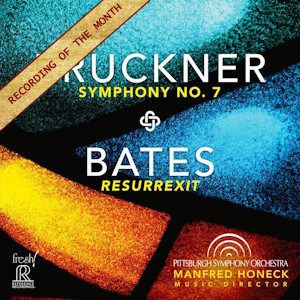
Anton Bruckner (1824-1896)
Symphony No. 7 in E major, WAB 107 (1883 ed. Nowak)
Mason Bates (b.1977)
Resurrexit
Pittsburgh Symphony Orchestra/Manfred Honeck
rec. live, 25-27 March 2022, Heinz Hall for the Performing Arts, Pittsburgh, USA
Reference Recordings FR-757SACD [78]
I have in general been impressed by the performances from Honeck and the Pittsburgh SO; they are in many ways one of the most interesting and rewarding partnerships on the modern classical scene, so I had great expectations of this new release. I was not disappointed; indeed, I was immediately gripped by the sheer breadth and majesty of the opening bars of this, Bruckner’s most accessible symphony alongside the Fourth – and credit for that must also go to the Bostonian Soundmirror engineers of this SACD; the depth and clarity of the sound here is astounding. Apparently this was recorded live; apart from the sheer electricity of the occasion so vividly communicated you would never guess that, it being completely free of any extraneous noise. It is very rich in bass; in fact, Honeck indicates that at one point in the Adagio he asks the double basses to play their line in the repeated and varied “non confundar” theme an octave lower than scored.
Honecks’s tempi are conventional – or perhaps I should say traditional, in contrast to the more recent trend for propulsion – and his emphasis is upon legato and sonority, just as I like my Bruckner; you can certainly hear how his experience as a member of the VPO has shaped his aesthetic. He favours what he calls “calm and broad” speeds; you feel as if every note carries weight and significance – and in his notes Honeck makes much of the spirituality of Bruckner’s music. The conclusion to the first movement is simply stupendous – the most Wagnerian I know, comparable in might and grandeur to any of the great moments in the Ring. That carries over into the Adagio. I can imagine that some might find Honeck’s manner a tad ponderous but I revel in its massive dignity. The Wagner tubas are as sonorous as any I have heard – although oddly, given Honeck’s predilection for grandeur over momentum, the great cymbal crash at 17:50 is very slightly under-cooked for my taste – but that climax is still hugely satisfying.
The Scherzo is first thunderously galumphing, then the Trio is swooningly soporific – and despite the opulence of the sound and the abundance of percussive energy Honeck brings to its execution, he is at pains to clarify the “birdsong” line running though the movement.
Honeck’s notes again point to a very audible refinement in the playing of the finale: the opening sounds like the flickering of Magic Fire, with the tremolos being accented “like a match being struck”. It is details such as this which enliven his performance and prevent it being too uniformly grandiose. The bank of brass blaring the “third thematic block” chorale at 2:58 and 6:46, too, is thrillingly aggressive – indeed, on fire, contrasting tellingly with the yodelling “Alpine” interludes. The coda is overwhelming in its power. Honeck melds and welds the disparate elements of this mercurial finale into a coherent entity of extraordinary impact.
Resurrexit was commissioned from Mason Bates to celebrate the sixtieth birthday of Manfred Honeck. It is a highly atmospheric, piquantly scored piece, spiced with sinuous Middle-Eastern sonorities; much of its idiom is perhaps traceable to predecessors heavily influenced by the music of more exotic cultures such as Saint-Saëns, Ravel and Rimsky Korsakov and I find its compact narrative of the Resurrection dramatic and relatable. Being so brief, it does not outstay its welcome and I thoroughly enjoy its gaudy exuberance.
The introduction, history and movement by movement guide to the Bruckner symphony by the conductor in the lavish colour booklet are full, detailed and stimulating. Alongside the musical guidance and reflection, he provides some amusing detail, such as a fact new to me, that of the main theme of the Scherzo Bruckner confessed, “It’s good, but unfortunately not by me. The melody was always sung by a cockerel, perched next to my house.”
This now becomes for me the equal of any recording I know; in fact, I am inclined to make it the prime recommendation.
Ralph Moore
Buying this recording via a link below generates revenue for MWI, which helps the site remain free




















